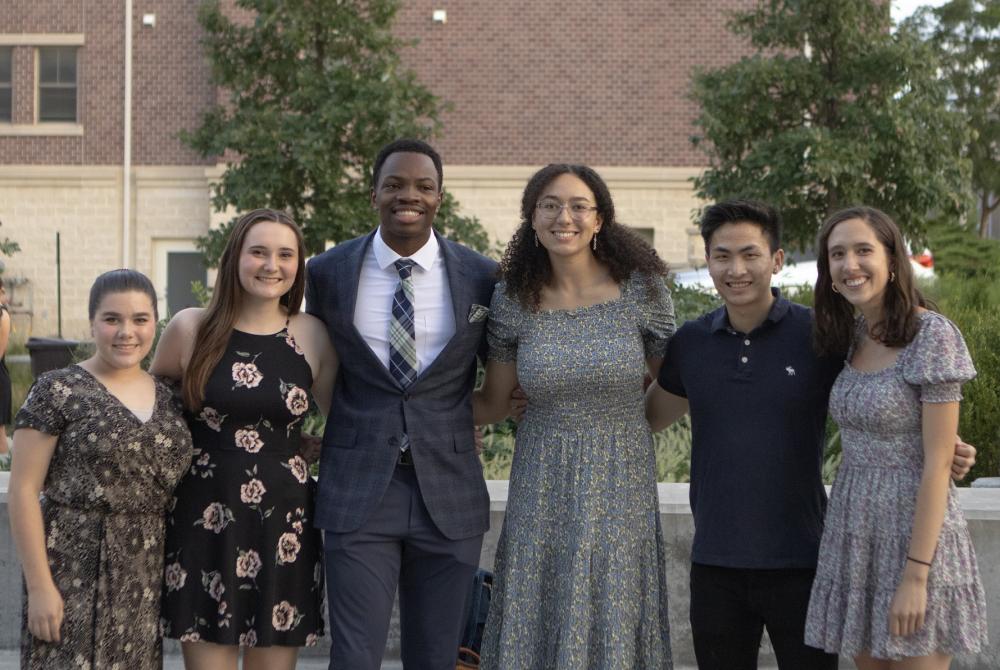
For information contact

Who should apply
Related fields
- Physics
- Biological Sciences
- Any engineering major with interest in medical applications
- Any science major with interest in medical applications
This program encourages applications from students with junior or senior standing.
Eligibility
Participation in the Nebraska Summer Research Program is limited to students who meet the following criteria:- U.S. Citizen or Permanent Resident
- Current undergraduate with at least one semester of coursework remaining before obtaining a bachelor's degree
See Eligibility for more information.
How to apply
Follow the application steps to submit the following materials.
About the Program
The Biomedical Engineering REU is designed to provide independent research experience for undergraduate students, broaden participant knowledge of opportunities in academia, industry and national laboratories, and introduce participants to interdisciplinary research in biomedical devices.
The goal of every medical practitioner is to improve quality of life for patients. Biomedical engineering and devices are instrumental in achieving this. The primary focus in each summer research project is biomedical devices designed to enhance medical care through science and engineering, with emphasis in two areas: (1) devices for diagnostics and sensing and (2) devices for therapeutics and intervention.
All projects are designed to be completed during the 10 week program and are a part of a faculty mentor's current research. This allows the student to be involved in many aspects of research, including design, analysis, simulation, and implementation of a biomedical device.
Students are also extensively involved in lab activities, such as weekly lab meetings. Research results are presented during lab meetings throughout the summer and at the end-of-summer in the Summer Research Symposium poster session. Lab members, especially graduate students and postdoctoral associates, are active with summer program research.
Benefits
- Competitive stipend: $7,000
- Suite-style room and meal plan
- Travel expenses to and from Lincoln
- Campus parking and/or bus pass
- Full access to the Campus Recreation Center and campus library system
- Wireless internet access
Learn more about academic and financial benefits.
Events
- Department seminars and presentations
- Professional development workshops (e.g., applying to graduate school, taking the GRE)
- Welcome picnic
- Day trip to Omaha's Henry Doorly Zoo and Aquarium
- Outdoor adventures
- Research symposium
Mentors and Projects
Dr. Greg Bashford, Dr. Eric Markvicka Biological Systems Engineering, Mechanical & Materials Engineering
Design and development of a wearable ultrasound patch for measuring cerebral blood flow
Ultrasound is a safe, noninvasive method of measuring blood flow in the body, and transcranial Doppler (TCD) is a special ultrasound mode that measures blood flow in cerebral arteries deep in the brain [5]. TCD may be used as an inexpensive, portable method to measure the brain’s response to stimuli since neural activity is correlated with blood flow in the cerebral cortex. However, it is currently challenging to continuously monitor brain response. In this context, skin-mounted wearable ultrasound devices emerge as a promising alternative, poised to facilitate prolonged, uninterrupted patient monitoring [6-9]. This project will create a wearable Doppler ultrasound patch for continuous measurement of cerebral blood flow (PI Markvicka). This project will also assess the use of a new data index based on systems theory (relaxation time; Co-PI Bashford). This is a team-based REU project where two students will work jointly with Dr. Bashford and Dr. Markvicka.
Dr. Nicole Iverson Biological Systems Engineering
Carbon Nanotube Sensor Platform to Quantify Nitric Oxide and Hydrogen Peroxide Levels in Inflammatory Diseases
Reactive oxygen and nitrogen species have been shown to be important factors in the progression of many diseases, ranging from autoimmune disease to cancer, but until recently there has been a lack in the ability of researchers to study nitric oxide and hydrogen peroxide (key reactive nitrogen and oxygen species) in real time. By wrapping carbon nanotubes with a specific DNA strand, a real time sensor for nitric oxide or hydrogen peroxide can be made. The student involved in this project will gain hands-on experience in BME research, with a focus on nanotechnology, sensors, and the engineering design process.
Dr. Forrest Kievit Biological Systems Engineering
Nanoparticle-Mediated Sensitization of Pediatric Brain Tumors to Radiotherapy
The field of nanomedicine offers the potential to improve the understanding and treatment of many disease processes by allowing researchers and clinicians the ability to deliver treatments to specific areas of the body, image where the treatments are going in real-time, and track responses. Therefore, the development of multifunctional nanoparticles has garnered significant attention especially for improving delivery into the brain for neurological diseases including traumatic brain injury, brain cancer, and dementia for which there is a significant lack of effective treatment options. These nanoparticles typically consist of a small core that acts as a scaffold to carry imaging agents for tracking nanoparticle localization in the body through various imaging modalities such as magnetic resonance and fluorescence imaging, therapeutic moieties for treatment, and targeting agents for binding cell surface receptors expressed in target tissue. However, the translation of nanomedicine into clinical use has been hindered by complicated nanoparticle designs that make reproducible synthesis and scale-up difficult. Therefore, a goal of the Kievit lab is to develop simplified synthesis strategies for multifunctional nanoparticles to improve their translatability.
Dr. Fanben Meng, Dr. Wei Niu, Dr. Yinsheng Guo Mechanical and Materials Engineering, Chemical & Biomolecular Engineering, Chemistry
Ultra-High-Throughput Microdroplet Screening for Protein Biologics Discovery
Protein biologics, e.g., antibodies and enzymes, are in high demand in applications ranging from affinity reagents in biomedical research and therapy to biocatalysts for the manufacturing of small-molecule drugs. The ability to quickly identify a protein of the desirable functionality is often limited by the throughput of the screening method. Three labs across the UNL campus work collaboratively on a project to develop and apply an ultra-high-throughput microdroplet method using lab-on-chip devices. This research team includes Dr. Wei Niu in Chemical and Biomolecular Engineering Department (protein engineering), Dr. Fanben Meng in Mechanical and Materials Engineering Department (microfluidic devices), and Dr. Yinsheng Guo in Chemistry Department (optical detections).
Dr. Nitesh Nama Mechanical and Materials Engineering
Ultrasound-Propelled Microswimmers for Manipulation of Synthetic Objects within Blood Vessels
The ability to move synthetic objects precisely within blood vessels can open exciting avenues for several applications in biomedicine and healthcare. Given the small size of blood vessels, an important requirement for achieving these functionalities is the ability to precisely direct a “microswimmer” in a controlled and tunable manner. The student will leverage computational approaches to devise novel acoustics-based propulsion approaches, that can enable controlled, tunable motion at microscales. The main research questions are the following: (1) What are the acoustic forces that govern the motion of a microswimmer? and (2) How can the operational parameters of the acoustic field (e.g., frequency, power) be optimized to achieve a desired motion of microswimmers to reach a specific target site?
Dr. Carl Nelson Mechanical and Materials Engineering
Robotic Technology for Next-Generation Minimally Invasive Surgery
Robotic tools are becoming a standard fixture in medicine, and particularly in surgery, where they can help enhance dexterity and visualization in minimally invasive approaches. Inserted, in-vivo robots (like miniature surgeon arms inside the abdomen) can have particularly high functionality. However, the small electric motors that typically drive these surgical robots are problematic: they take up too much space for too little force and speed capability, and electrical connections multiply the possible failure modes and reduce reliability.
Dr. Angela Pannier Biological Systems Engineering
DNA-Loaded Nanocarriers for Enhanced Oral Gene Delivery and Vaccination
Oral gene delivery offers a promising strategy for gene-based therapy. It is non-invasive, convenient, and can be used for both local and systemic gene production. This includes treating gastrointestinal diseases and using DNA delivery for vaccination. However, nonviral methods face challenges in protecting DNA and promoting uptake by intestinal cells, resulting in low transgene expression. To address this, we are developing DNA-loaded OMV nanocarriers (DNA-OMV NCs) derived from gut bacteria.
Dr. Ryan Pedrigi Mechanical and Materials Engineering
Ultrasound as a Mechanotherapy for Heart Disease and Stroke
Atherosclerosis is the fundamental pathology in heart disease and ischemic stroke characterized by the accumulation of fat and immune cells in the inner lining of arteries. An interesting feature of this disease is that these fatty plaques tend to form in regions of arteries that experience certain mechanical interactions between blood flow and the endothelial cells that sit at the inner lining of arteries. The ability to deliver beneficial mechanical stimuli to endothelial cells in these artery regions could be therapeutic. We are currently studying the use of ultrasound for this purpose and ultimately aim to develop a new therapy for atherosclerosis using this technology. This project will work on characterizing the biological response of endothelial cells to ultrasound.
Dr. Benjamin Riggan Electrical and Computer Engineering
Domain Adaptative Computer Vision Algorithms for Biomedical Image Analysis
Computer vision (CV) and image processing techniques are advanced methods for biomedical image analysis with applications in lesion detection and segmentation, clustering, tracking, and identification across multiple imaging modalities (e.g., X-ray, Computed Tomography, and Functional Magnetic Resonance Imaging). The project is multidisciplinary and will expose the REU student to principles from physics, biomedical engineering, signal processing, and computer science, while gaining experience with biomedical sensors, devices, data, and algorithms.
Dr. Rebecca Wachs Biological Systems Engineering
Biomaterials and Therapeutics to Prevent Low Back Pain
Low back pain, recognized as a widespread clinical problem, is one source of orthopedic pain resulting from degeneration and innervation of the intervertebral disc [14, 15]. Prevention of nerve growth into the intervertebral disc and reduction of painful stimuli has the potential to prevent disc-associated low back pain independent of disc degeneration. Our lab develops natural biomaterial scaffolds to prevent undesired nerve growth and reduce nerve stimulation. This project will work on developing and characterizing these natural material scaffolds and drug delivery devices to treat low back pain.